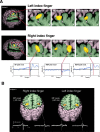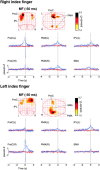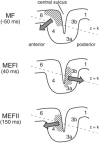Spatiotemporal mapping of cortical activity accompanying voluntary movements using an event-related beamforming approach
- PMID: 16037985
- PMCID: PMC6871358
- DOI: 10.1002/hbm.20178
Spatiotemporal mapping of cortical activity accompanying voluntary movements using an event-related beamforming approach
Abstract
We describe a novel spatial filtering approach to the localization of cortical activity accompanying voluntary movements. The synthetic aperture magnetometry (SAM) minimum-variance beamformer algorithm was used to compute spatial filters three-dimensionally over the entire brain from single trial neuromagnetic recordings of subjects performing self-paced index finger movements. Images of instantaneous source power ("event-related SAM") computed at selected latencies revealed activation of multiple cortical motor areas prior to and following left and right index finger movements in individual subjects, even in the presence of low-frequency noise (e.g., eye movements). A slow premovement motor field (MF) reaching maximal amplitude approximately 50 ms prior to movement onset was localized to the hand area of contralateral precentral gyrus, followed by activity in the contralateral postcentral gyrus at 40 ms, corresponding to the first movement-evoked field (MEFI). A novel finding was a second activation of the precentral gyrus at a latency of approximately 150 ms, corresponding to the second movement-evoked field (MEFII). Group averaging of spatially normalized images indicated additional premovement activity in the ipsilateral precentral gyrus and the left inferior parietal cortex for both left and right finger movements. Weaker activations were also observed in bilateral premotor areas and the supplementary motor area. These results show that event-related beamforming provides a robust method for studying complex patterns of time-locked cortical activity accompanying voluntary movements, and offers a new approach for the localization of multiple cortical sources derived from neuromagnetic recordings in single subject and group data.
Copyright 2005 Wiley-Liss, Inc.
Figures






Similar articles
-
Cortical neuromagnetic fields evoked by voluntary and passive hand movements in healthy adults.J Clin Neurophysiol. 2003 Apr;20(2):94-101. doi: 10.1097/00004691-200304000-00002. J Clin Neurophysiol. 2003. PMID: 12766681 Clinical Trial.
-
Post-movement beta rebound is generated in motor cortex: evidence from neuromagnetic recordings.Neuroimage. 2006 Sep;32(3):1281-9. doi: 10.1016/j.neuroimage.2006.06.005. Epub 2006 Jul 25. Neuroimage. 2006. PMID: 16863693
-
Localization, timing and specificity of gating of somatosensory evoked potentials during active movement in man.Brain. 1987 Apr;110 ( Pt 2):451-67. doi: 10.1093/brain/110.2.451. Brain. 1987. PMID: 3567532
-
Electroencephalographic and magnetoencephalographic studies of motor function.Adv Neurol. 1990;54:193-205. Adv Neurol. 1990. PMID: 2270804 Review.
-
A quantitative meta-analysis and review of motor learning in the human brain.Neuroimage. 2013 Feb 15;67:283-97. doi: 10.1016/j.neuroimage.2012.11.020. Epub 2012 Nov 27. Neuroimage. 2013. PMID: 23194819 Free PMC article. Review.
Cited by
-
Neural oscillatory dynamics of inhibitory control in young adult binge drinkers.Biol Psychol. 2019 Sep;146:107732. doi: 10.1016/j.biopsycho.2019.107732. Epub 2019 Jul 22. Biol Psychol. 2019. PMID: 31344371 Free PMC article.
-
Spinal cord microstructural changes are connected with the aberrant sensorimotor cortical oscillatory activity in adults with cerebral palsy.Sci Rep. 2022 Mar 21;12(1):4807. doi: 10.1038/s41598-022-08741-9. Sci Rep. 2022. PMID: 35314729 Free PMC article.
-
Altered motor dynamics in type 1 diabetes modulate behavioral performance.Neuroimage Clin. 2019;24:101977. doi: 10.1016/j.nicl.2019.101977. Epub 2019 Aug 7. Neuroimage Clin. 2019. PMID: 31466021 Free PMC article.
-
Rapid tuning of auditory "what" and "where" pathways by training.Cereb Cortex. 2015 Feb;25(2):496-506. doi: 10.1093/cercor/bht251. Epub 2013 Sep 15. Cereb Cortex. 2015. PMID: 24042339 Free PMC article. Clinical Trial.
-
Neurophysiological changes in the visuomotor network after practicing a motor task.J Neurophysiol. 2018 Jul 1;120(1):239-249. doi: 10.1152/jn.00020.2018. Epub 2018 Mar 28. J Neurophysiol. 2018. PMID: 29589817 Free PMC article.
References
-
- Alkadhi H, Crelier GR, Boendermaker SH, Hepp‐Reymond MC, Kollias SS (2002): Somatotopy in the ipsilateral primary motor cortex. Neuroreport 13: 2065–2070. - PubMed
-
- Allison JD, Meador KJ, Loring DW, Figueroa RE, Wright JC (2000): Functional MRI cerebral activation and deactivation during finger movement. Neurology 54: 135–142. - PubMed
-
- Andersen RA, Snyder LH, Bradley DC, Xing J (1997): Multimodal representation of space in the posterior parietal cortex and its use in planning movements. Annu Rev Neurosci 20: 303–330. - PubMed
-
- Bakhtazad L, Gaetz W, Cheyne D (2004): High resolution neuromagnetic imaging using minimum‐variance beamforming reveals multiple generators of movement‐evoked fields. In: Halgren E, Ahlfors S, Hamalainen M, Cohen D, editors. Proc 14th Int Conf Biomagnetism. Boston: Biomag 2004. p 723.
Publication types
MeSH terms
LinkOut - more resources
Full Text Sources

